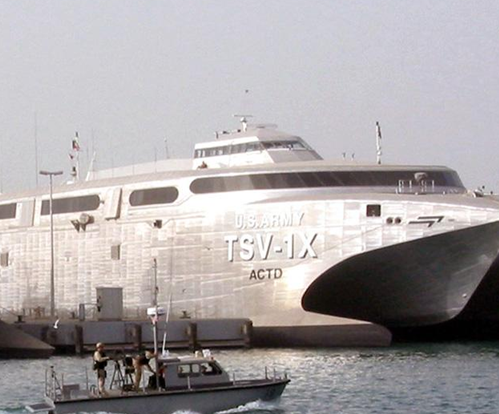

Army Catamaran Hauls Equipment Double-time
liding out of port on the Army's experimental heavy-lift catamaran, the U.S. Army Vessel Spearhead, peering out the window is almost the only way to get a sense of motion.
Hardly the sail-driven skateboard-on-water of popular imagination, this diesel-engine catamaran always keeps both keels in the water while hauling heavy payloads of equipment, personnel and vehicles.
The Spearhead, hull number TSV-1X, which stands for "Theater Support Vessel - 1st Experimental, still bears a few reminders of its nine-year civilian past as a high-speed ferry between the Australian mainland and Tasmania. Most notably, there's the blue-and-rainbow-speckled carpet and passenger seating in the main-deck cabin. The large blue sunroof doesn't exactly shout "military" either.But standing in front of the docked craft, one could hardly mistake it for a civilian cruise ship.
The vessel's exterior is a glimmering silver, its aluminum skin left unpainted to save 9 tons of weight in paint. In fact, nearly the entire frame is aluminum, a material chosen over steel for its lightweight and rust resistance. The vessel's military-civilian hybrid appearance is a result of remodeling that was put on hold because the craft was needed in the Persian Gulf in preparation for Operation Iraqi Freedom.
The Spearhead is the latest catamaran with which the military has been experimenting for the last two years after seeing similar craft operated by the Australian navy during the East Timor crisis in 1999 and 2000.
The high-speed vessel HSV-X1 Joint Venture, built by Incat Ltd. in Australia -- as was the Spearhead -- is being leased from the company by the Navy and Army in a joint venture. Until recently, U.S. Central Command also used it in Operation Iraqi Freedom.
Incat recently finished building another catamaran for the Navy, the HSV-X2, which will be stationed in Ingleside, Texas. Future catamarans for the military are planned to be built by Bollinger-Incat USA in New Orleans. The Army plans to deploy up to 17 TSVs around the world by 2011.
The Spearhead is an all-Army endeavor, operated by the 469th Transportation Detachment, Fort Eustis, Va. Last fall, a crew of Army sailors went to Hobart, Tasmania, to train on the vessel before sailing it to the Persian Gulf. One initial training crew member was Sgt. Victor Rondon III, a watercraft engineer.
"We took safety classes and an engine-room class to familiarize us with the engineering equipment, Rondon said, "and we christened the ship 'Hobart.' The navigators went to high-speed navigation school at the Maritime College in Tasmania."
Rondon said Army engineers have to be versatile. Unlike the Navy, which has a specialist for nearly every task aboard a ship, Army "sailors" must multitask, since the crew size -- about half that of a comparable Navy vessel -- is small, and operational doctrine still is being written for the TSV, he explained.
"We maintain the engine, hydraulics, electrical system -- whatever it is, you name it, we fix it. It keeps us busy. It's a lot of work, but we learn a lot," Rondon said. "We even make our own water, using reverse osmosis. We can make about 15 gallons per minute converting sea water to fresh water," he added.
The four-engine, 98-meter TSV has significantly more advanced engines and generators compared to the HSV, said Anthony Dasig, a TSV engineer. Dasig said the TSV is faster and holds more cargo than the HSV.
Compared to the longtime Army workhorse vessel -- the LSV, or Logistical Support Vessel, the TSV is four times faster at over 40 knots and can carry a more voluminous, though less heavy load, Dasig said.
After training in Hobart, the 31-member crew sailed the vessel to the Persian Gulf in December. Except for one month for maintenance, it has been in continuous service, logging more than 50,000 nautical miles (57,500 statute miles).
TSV missions have included hauling two Patriot missile battalions from Qatar to the Kuwaiti naval base in a joint effort with the LSVs in theater.
The TSV also moved the 101st Airborne Division military police from Djibouti to Kuwait, making the 2,000-mile trip in two and a half days. The LSV would have needed 10 days to make the voyage and could only hold equipment, requiring the troops to fly separately, said Chief Warrant Officer Bill Slusher, the TSV navigation officer. The TSV also carried 500 tons of ammunition from Jordan's Aqaba Port to Kuwait.
"The primary mission for the TSV is to lift soldiers with their equipment together, along with food, water and fuel," Slusher said.
Since the vessel is experimental, the Army wants to know how it has performed in theater. Both enlisted and officer crew members meet regularly to conduct after-action reviews of the vessel's performance.
"We're basically the crew to say whether to keep it or scrap it," said Rondon. "We get together with the officers and come up with solutions instead of just saying something doesn't work."
Slusher said, "Operationally, the boat the Army ultimately wants will be bigger.The goal is to carry two Stryker units. This one (the Spearhead) carries only one."
The Stryker is a new eight-wheeled, 20-ton armored troop carrier designed to replace older tracked vehicles.
Slusher said minor modifications would be made to the TSV crew berthing.And, of course, the rainbow carpet would have to go.
The TSV is more like an aircraft than an LSV when calculating for cargo, said Chief Warrant Officer Patrick May, the TSV commander, known as the vessel master. "When we carry more fuel for longer distances, we have to carry less cargo. With an LSV, it's not necessary to take that into account."
Another difference from the LSV is docking. With a shallow draft of 3.4 meters, the TSV can get into ports an LSV cannot. It also can unload its cargo from directly astern or at up to a 45-degree angle off its rear corner if necessary.
May, who skippered an LSV for much of his 19-year military career, explained how the TSV is docked compared to an LSV.
"On an LSV, when docking and undocking, a sailor yells commands to the helmsman. With the TSV, we lose sight of the pier within 25 meters, so we have docking cameras and spotters on the stern and bow. I use a joystick to dock the vessel. It is a very maneuverable craft, once you get used to it."
The vessel has cameras in the engine rooms, as well as 900 sensors continuously monitoring the vessel's systems. The TSV has about twice as many sensors as an LSV, yet with the same size crew.
Shifts on the TSV are four hours on, eight off, said 1st Sgt. Michael Kelly, a senior navigator with the 469th. Since the ship was originally designed for fairly short trips in a much cooler climate than Kuwait, where summer temperatures often are in the 120s, maintenance has been high, according to Kelly.
"There is always a roving engineer on duty down below deck. We have an alarm about every other day. Usually it's a sensor tripped because of the heat, but we're required to check it out," Kelly said. "Heat has taken its toll here, especially on the air-conditioning system and refrigerators."
Kelly explained the 469th is a self-contained unit, as is the crew of the TSV. "All the administration functions a regular unit would have, we do as well," he said."We have e-mail, fax and phone capabilities onboard."
Kelly, with 21 years as an Army sailor, has nearly completed traveling around the world in Army watercraft. He will complete the last leg of his circumnavigation when the TSV returns to Hobart in November for further modifications.



















